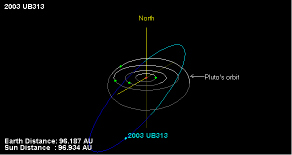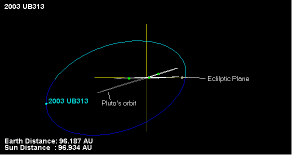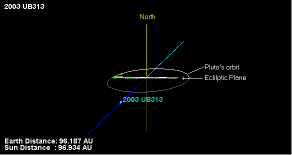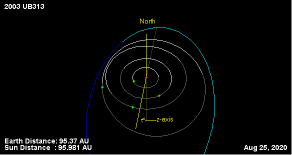A new planet has been discovered by astronomer Michael Brown of the California Institute of Technology that’s larger than Pluto. It must be exciting to discover a planet. I mentioned it in a prior post.
Astrologers are going to have some issues with using this planet in their practice. With UB313’s declination of about +/- 45 degrees (!), the planet will only pass through some of the typical zodiacal signs at nodal points +/- some number of threshold declination degrees. Will these nodal points themselves cycle through the zodiacal signs? Probably, but I don’t know right now at what periodicity or cyclical pattern that nodal movement might follow, and the nodal points are not the same as planetary location except for the briefest of time periods. I’m sure programmers of astrological software will include the planet in new versions shortly, but there are technical matters that I hope they consider, one of which is inclusion of all planets nodal points and apside line placements.
As an mental illustration, what movement would happen in the typical astrological chart if a ‘hypothetical’ planet is discovered that has an declination of +/- 90 degrees and its movement is to be viewed in a natal chart display? Let’s further stipulate that with this hypothetical there will be no nodal movement through zodiacal signs. In this case, planetary movement would appear solely digital! In other words, no movement on the standard astrological chart would occur over time until the planets orbital path passed through a line defined by its perpendicularity to the ecliptic plane and drawn through the Sun. Once that orbital path conjuncted the perpendicular line, either north or south of the Sun, then the chart symbol would “jump” to some point on the opposite side of the same chart, and remain there until it passed through the opposite solar side of the north-south line. This would mean that the traditional zodiacal assignment would only be accurate in sidereal for a small amount of time when the planet is near the nodes—the planet’s orbital intersection points with the ecliptic plane.
While the reported 45-degree inclination of 2003UB313 is less than 90-degrees, the same type of synthetic chart phenomenon would still occur, but less severely. Therefore, its my current thinking, that if any typical zodiac such as Western tropical or sidereal is applied to this planet throughout most of its travel on a 2-dimensional representation such as a typical natal chart, most of the time zodiacal assignment will be wrong for the new planet, and the best that could be said is that it would be a synthetic assignment without much basis in background star influence except for the briefest of periods when it’s near one of the two ecliptic intersection nodes. Continuing to use old technical methods of astrology with this new planet will hide its truth to all but a few astrologers, and the same might be said of Pluto, as well.
Here are some illustrations, courtesy of JPL’s java applet. You may click on any of the images to see a larger version.
 This first graphic shows Saturn through 2003UB313 and their orbital paths with Saturn’s orbit closest to the Sun or central point. The Sun is represented with a red dot and with a yellow north line and z-axis anchor.
This first graphic shows Saturn through 2003UB313 and their orbital paths with Saturn’s orbit closest to the Sun or central point. The Sun is represented with a red dot and with a yellow north line and z-axis anchor.
 In this next graphic I’ve rotated the representation to show the ecliptic plane as if one was looking at a plate on a table with one’s horizontal view positioned at the table’s top edge. In this and the next grapic, the perspective causes the ecliptic plane to appear as a horizontal line. In this graphic Pluto’s orbital path also appears as a line, the angular difference between the two planes is one way of conceptualizing declination.
In this next graphic I’ve rotated the representation to show the ecliptic plane as if one was looking at a plate on a table with one’s horizontal view positioned at the table’s top edge. In this and the next grapic, the perspective causes the ecliptic plane to appear as a horizontal line. In this graphic Pluto’s orbital path also appears as a line, the angular difference between the two planes is one way of conceptualizing declination.
 In this graphic I’ve rotated the perspective so that 2003UB313 orbital path and the ecliptic are both viewed as lines, and Pluto’s orbit is circular. The new planet’s steep declination versus all other planets’ paths is quite visible, and it appears close to 45 degrees as measured against the ecliptic plane.
In this graphic I’ve rotated the perspective so that 2003UB313 orbital path and the ecliptic are both viewed as lines, and Pluto’s orbit is circular. The new planet’s steep declination versus all other planets’ paths is quite visible, and it appears close to 45 degrees as measured against the ecliptic plane.
It should now be easy to visually understand why the new planet will not travel through the typical background constellations or zodiac signs, except at the nodal points where it’s path intersects with the ecliptic plane. Shouldn’t this create a large interpretive error for astrologers who will say that it travels through each one of the ‘typical’ or popular zodiacal constellations?
Another interpretive point of consideration is that when 2003UB313 is at steep + or – declination, how will astrologers ever be able to honestly say it’s conjuncting one of the more inward planets? At this point of declination, + or – 45 degrees approximately, a conjunction with another planet of 0 declination would at best be a semi-square, which curiously would change its aspectual ease or difficulty, wouldn’t it? There’s a similar issue with Pluto, but it’s also not as pronounced as it will be with this new planet.
Following this reasoning, and making the assumption that half of 2003UB313’s stated orbital period is a close approximation, then traditional zodiacal effects such as traditional aspects to it would imply they will only occur for relatively short periods of time and at a mean bisected-cycle of approximately 278 years (557/2). Because of the typical elongation of the apside line axis relative to the nodal axis, and the faster planetary velocity at perigee than at apogee, this crude average approximation is no doubt off by some amount. Further, if considering that there is likely movement of nodal points through the zodiac, then for interpretation, researching any historical (or real time) effects during 2003UB313s conjunction to its nodes will have changing zodiacal interpretive qualities at each period of nodal intersection with each return.
As far as I know, no astrological program graphically plots all planets’ nodal points, or apse line, but then I don’t have any of the latest and greatest commercial programs. Most do plot the Moon’s nodes and some plot the associated focal point of Lilith. Perhaps Astrolabe’s NOVA did plot these phenomenon, but I never had access to that program to play with, it was too expensive for me at a time way back when, when I was actively interested in such things :(. It’s an area for astrological software improvement, I think.
One way this might be addressed is with a more refined 2-dimensional chart that has circles within the typical circular placement of zodiacal sign. The inner (or outer) added circles would have different zodiacal assignments than the traditional ones, this added group of signs would be defined by the background star patterns on the plane defined by the new planet’s orbit.
There may be other valid symbolic ways of approaching this issue.
This would be preferable to the 2-dimensional visual representation that outer planets orbits “mix it up” either zodiacally or by intersecting with other inner planets’ orbits such as Pluto currently does with Neptune, or which will be much more pronounced now with 2003UB313 in the typical and traditional astrological chart wheel. Astronomer Mike Brown has an image of such a “mixing it up” phenomenon when its viewed in two dimensions from above (or below?). Where the orbital lines appear to cross might give a false idea of the planet’s astrological energies.
 In this last graphic, when viewed from a particular angle, it can still be seen that the outer planet orbits do not intersect.
In this last graphic, when viewed from a particular angle, it can still be seen that the outer planet orbits do not intersect.